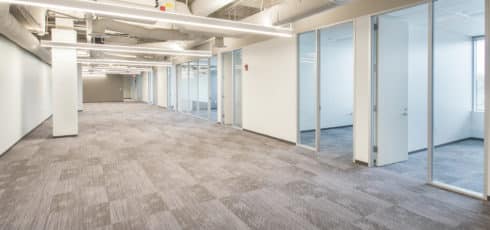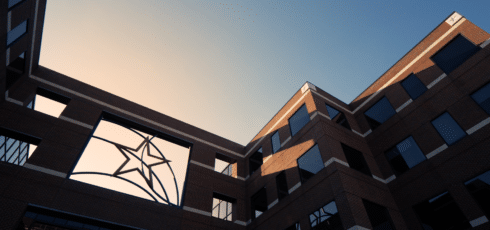Underwriting is utilized in nearly every aspect of commercial real estate investing, from the investor buying or selling the property to the bank offering the loan. During the underwriting process, numerous words and abbreviations are commonly used that may not be in the lexicon of those not involved with underwriting on a regular basis.
Underwriting is the process of establishing both the risk and potential return of all types of investments, whether it be a real estate investor purchasing a building, a bank issuing a loan or an investment banker evaluating a stock.
Read Now: Evaluating a Property: Underwriting Commercial Real Estate Acquisitions
To help alleviate some of the confusion surrounding the vocabulary used in underwriting, we have outlined the most common terms and definitions below.
Common Commercial Real Estate Underwriting Terms and Definitions
Gross Potential Income
Gross Potential Income (GPI) is the total potential income a property can produce each year if it is fully leased.
Gross Potential Income = Building’s Rentable Square Feet x Full-Service Rent
For example, a 100,000-rentable-square-foot building with a full-service rate of $40 per square foot per year has a GPI of $4 million. (100,000 RSF x $40/SF/YR = $4 million GPI)
This number is commonly used by underwriters as the starting point for the analysis. Operating expenses, vacancy, and more will all be subtracted from GPI during the underwriting process.
Operating Expenses
Just like a residential property, commercial properties have recurring expenses related to owning and maintaining the building that must be paid every year. These costs are called operating expenses (Op/Ex) and include property taxes, insurance, and common area maintenance, or CAM. Typically, what is included in CAM for office buildings is electricity, janitorial, management fees, etc.
To learn more about what can be included in CAM expenses for each property type, read our article What Are Common Area Maintenance (CAM) Fees.
These expenses will be billed back to building tenants through their gross rent or operating expenses.
Vacancy Allowance
While every commercial real estate investor would like their building to be 100% leased at all times, most understand that a vacancy is likely to occur at some point during the CRE investment period.
To account for this, the underwriter will factor in the cost of vacancy to provide a more realistic forecast of future cash flows. Standards will vary depending on market conditions and preference, but an allowance between 5% – 10% is not uncommon.
For example, if our 100,000-rentable-square-foot building above has a vacancy allowance of 5%, the underwriter will deduct $200,000 from the annual GPI. ($4 million GPI * 5% Vacancy Allowance = $200,000)
Annual Vacancy Allowance = Estimated Vacancy % x Building’s Rentable Square Feet x Full-Service Rental Rate
Bad Debt Expense
Similar to a vacancy allowance, bad debt expense is a tool used by underwriters to account for the chance that a tenant will be late to pay rent or even default completely.
Bad debt expense could receive its own line in an analysis, or be combined with the vacancy allowance estimate. Like with a vacancy allowance, there is no standard adjustment for bad debt expense; underwriters rely mostly on market conditions and preference to gauge this metric.
For example, if our 100,000-rentable-square-foot building has a forecasted bad debt expense of 5%, it will have $200,000 deducted from the annual GPI. ($4 million GPI * 5% Bad Debt Expense = $200,000)
Bad Debt Expense = Estimated Bad Debt % x Building’s Rentable Square Feet x Full-Service Rental Rate
Net Operating Income
Net Operating Income (NOI) is an important metric used when evaluating the profitability of a project or calculating its value. The NOI measures the actual income a building will produce in a year after operating expenses are paid. The NOI also factors in a vacancy allowance and bad debt expense, providing a realistic measure of what the building’s income will look like when not 100% occupied.
NOI = GPI – Op/Ex – Vacancy Allowance – Bad Debt Expense
Cap Rate
The Capitalization Rate (Cap Rate) is a fundamental metric used in valuing commercial real estate.
The Cap Rate is the annual percentage return of a property based on the future income (forward annual NOI) that the property will generate.
Cap Rate = Forward Annual NOI / Purchase Price
Due to the inverse relationship between cap rate and purchase price, a low cap rate (3% to 6%) will generally indicate a more expensive purchase, and a higher cap rate (7% to 10%) will indicate a comparatively more affordable one.
For example, assuming a forward annual NOI of $100,000 is held constant, a purchase price of $1,000,000 will yield a cap rate of 10% ($100,000/$1,000,000 = 10%), while a higher purchase price of $2,000,000 will yield a cap rate of 5% ($100,000/$2,000,000 = 5%).
Property Value
Finding an estimated valuation (property value) for the commercial real estate investment is the ultimate goal of underwriting.
To do this, the underwriter will use the building’s forecasted annual NOI in conjunction with the desired cap rate to place a final dollar amount on the deal at hand.
Property Value = Forward Annual NOI / Cap Rate
In order to find the appropriate cap rate to use in this analysis, the underwriter will look at the cap rates of recently sold comparable buildings in the market, similar to how a residential real estate agent might look at recent home sales to determine what their client’s home is worth.
Essentially, if you know what you anticipate the building to produce each year, and you know what cap rate similar buildings are being sold at in your market, you can use these numbers to back in to the property value.
This value is generally the maximum a commercial real estate investor would be willing to pay for the property and can change during the negotiation process as variables are altered.
For example, if the underwriter knows the building’s forward annual NOI is $100,000, and also knows that similar buildings in the area have been sold with a cap rate of 5%, the underwriter can calculate that an appropriate price for the building in question is $2,000,000. ($2,000,000 = $100,000 / 5%)
Note: By rearranging this formula, you can also calculate a building’s cap rate if the NOI and purchase price are known. This can be useful when analyzing sale comparables to determine an appropriate cap rate for the property in question.
Stress Test
A stress test is a simulation technique that measures how an asset or liability will perform under different scenarios.
For example, a commercial real estate investor may run a stress test by inputting different predicted rental rates to see how it will impact a project’s forecasted return, or may vary the estimated vacancy rate to show if the project will still be profitable if demand is lower than anticipated.
Loan-to-Value Ratio
When using a loan to fund a commercial real estate investment, it is common for the lender to only fund a percentage of the CRE investment’s total value. This percentage, the Loan-to-Value (LTV) ratio, can be used to calculate the amount of debt, and thus the amount of equity, required for the CRE investment.
Loan Amount = Loan-to-Value % x Assessed Value
For example, if the CRE investment’s value is $100M and the lender will only offer 70% LTV, the CRE investor will receive $70M of debt and be required to fund the remaining $30M with equity.
Equity Required
Because most lenders will not fund 100% of a CRE investment’s value, the investor will usually need to provide equity to make up the difference. Commercial real estate investors will generally try to limit the amount of equity required, due both to a limited amount of cash and the financial benefits of using debt (also known as leverage) in transactions.
The equity required can be found by finding the difference between the purchase price and the loan amount.
Equity Required = Purchase Price – Loan Amount
Debt Service Coverage Ratio
The Debt Service Coverage Ratio (DSCR) is the ratio of a property’s NOI to its annual mortgage.
For example, a property with an NOI of $125,000 and an annual mortgage debt service of $100,000 will have a DSCR of 1.25.
DSCR = NOI / Annual Mortgage
This metric is the first thing lenders will consider when determining the loan amount they are able to lend. A higher ratio means a lower risk of default, and because of this, projects with higher ratios may be able to obtain larger loans.
Net Present Value
Net Present Value (NPV) is a metric used to value future cash flows of a commercial real estate investment by discounting the cash flows to their present value.
Due to the time value of money and uncertainty of the future, cash flow tomorrow is not as valuable as an equivalent cash flow today.
To account for this in the underwriting process, the projected cash flow of the CRE investment is “discounted” by a discount rate (usually between 6% to 15% for an office project depending on the risk profile of the CRE investment and the buyer’s cost of capital).
NPV combines all future cash flows of a CRE investment and presents them as a value in today’s dollars. This is used as a way to not only gauge whether the CRE investment will generate revenue, but whether that revenue will be of value after taking into account the time and risk it takes to receive it.
NPV = [Cash Flow1 / (1 + discount rate)1] + [Cash Flow2 / (1 + discount rate)2] + [Cash Flow3 / (1 + discount rate)3] + … [Cash Flown / (1 + discount rate)n]
For example:
| Year 0 | Year 1 | Year 2 | Year 3 | |
| Discount Rate | 10% | 10% | 10% | 10% |
| Cash Flow | $100,000 | $100,000 | $100,000 | $100,000 |
| Discounted Cash Flow | $100,000 | $90,909 | $82,645 | $75,131 |
Internal Rate of Return
Internal Rate of Return (IRR) is a metric used to estimate the profitability of potential CRE investments. It is the discount rate that makes the NPV of all cash flows from a particular project equal to zero, giving the CRE investor a benchmark for a break-even return. If the IRR is higher than the chosen discount rate, the NPV will be positive, indicating that the CRE investment will produce more money than was originally put in. In general, the CRE investment with the highest IRR is the one you should pursue.
IRR provides a concise overview of a CRE investment’s return over the entire holding period and is a commonly used tool in the world of underwriting. This, when combined with an NPV analysis, helps a CRE investor understand the value of a CRE investment in terms of today’s dollars. For more information on what IRR is and how it is calculated, read more here.
Return on Cost
This value represents the annual return of the project as a whole, not taking into account the amount of debt or equity used to make the initial acquisition. Return on cost is to be used for the purchase of an existing, stabilized building.
Return on Cost = Annual NOI / Cost of the CRE Investment
For example, if a building has an annual NOI of $100,000 and the purchase price of the building was $2,000,000, the return on cost per year is 5%.
Note: While Return on Cost and Cap Rate are very similar, the difference lies in how they are used. Return on Cost is used when evaluating the CRE investment through the owner’s holding period, while Cap Rate is used as a tool for valuing a building. For example, a CRE investor wanting to know what yield the building will generate in Year 3 would ask to see the Return on Cost, not the Cap Rate.
Stabilization
Stabilization is a term commonly used in development projects to indicate a building that has reached a “stable” stream of income by having a certain percentage of the building leased. This percentage will depend on the class of the asset and the type of building, but, in general, 95% leased is considered “stabilized” for an office building.
Developers aim to reach stabilization as quickly as possible once construction is complete.
Development Yield
Development Yield is essentially the Return on Cost of a development project upon stabilization.
Development Yield = Annual NOI at Stabilization / Cost of the Project
For example, if a project reached a stabilized annual NOI of $100,000 and cost $2,000,000 to build, the annual development yield would be 5%.
Return on Investment
Return on Investment (ROI), also referred to as the Return on Equity, is a measure of the cash flow that is returned to the investor.
It is equal to the Annual Distributable Cash Flow to the CRE investor (NOI minus all capital expenses and debt service payments) divided by the equity invested in the project.
ROI = [NOI – (Capital Expenses + Debt Service Payments)] / Equity Invested
Conclusion
As you can see, there is a multitude of terms utilized in the underwriting process that is likely not in the lexicon of those new to the process. Learning these definitions can be a hurdle to overcome, but doing so is a worthwhile endeavor for anyone interested in commercial real estate investing.
If you would like to learn more about the underwriting process or are looking for assistance in underwriting your own CRE investment, our experienced commercial real estate investment services team will be happy to lend a hand.
Or to read more about the process of underwriting a real estate property, read our article Evaluating a Property: Underwriting Commercial Real Estate Acquisitions.
Popular Articles:
- Best Commercial Real Estate Investment Sales Brokerage Firms to Buy and Sell Property in Austin, Texas
- How Much Does It Cost to Use a Broker to Buy or Sell a Property?
- How Much Does It Cost to Market a Commercial Property?














